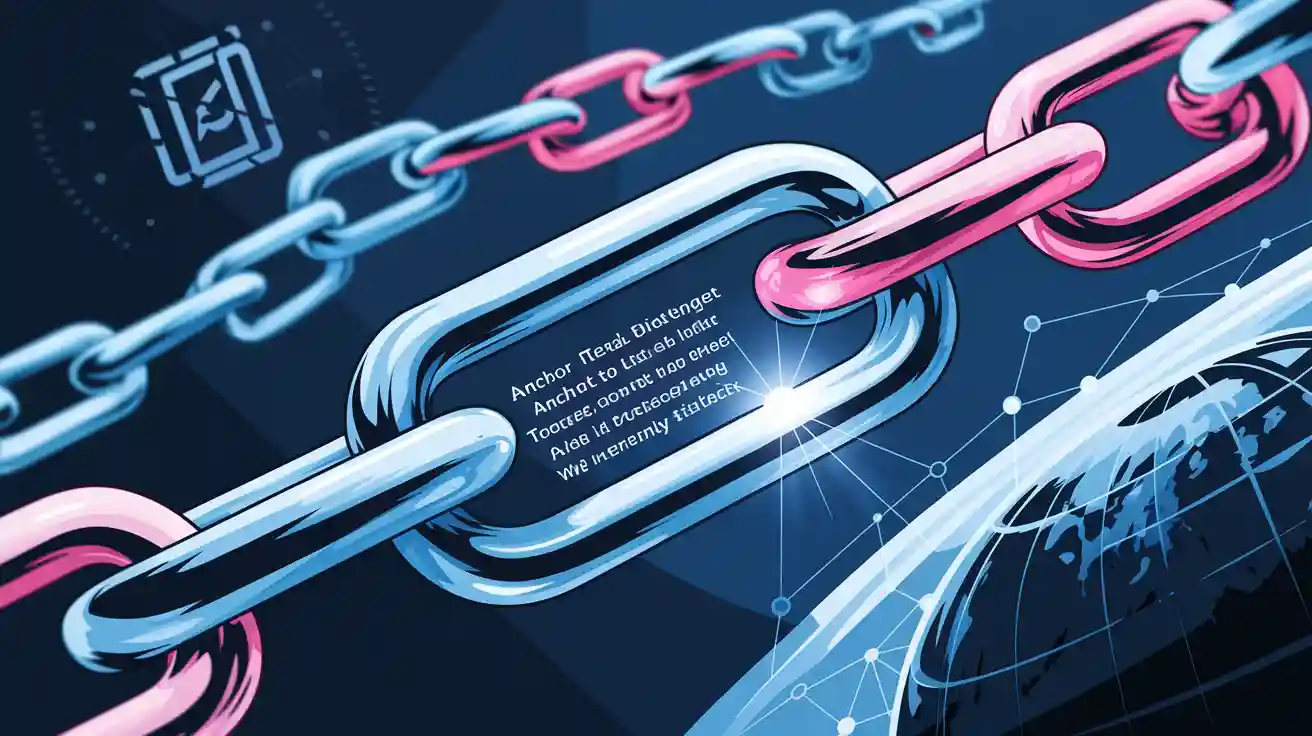Understanding Anchor Text for Backlinks

Anchor text is the clickable part of a link. It is often underlined or looks different to show it can be clicked. It links one webpage to another, helping users and search engines find related content. Search engines use anchor text to understand what linked pages are about. For example, research shows websites with different types of anchor text in their links get more user activity. People spend 50% more time on these sites and view more pages. Also, the Reasonable Surfer model shows that anchor text helps search rankings by showing what is important and relevant.
Key Takeaways
Anchor text is the clickable words in a link. It helps users and search engines find related pages.
Using different types of anchor text, like exact match or brand names, boosts your site's SEO and visibility.
Clear and simple anchor text makes it easier for users and search engines to understand your content.
Don’t use the same keywords too much in anchor text. This can lead to penalties. Use a natural mix instead.
Check and update your anchor text often to keep it working well with SEO rules.
What Is Anchor Text and Its Role in SEO?
Definition and Examples of Anchor Text
Anchor text is the clickable words in a link. It connects one webpage to another and helps users and search engines find related content. Usually, anchor text is underlined or highlighted so you know it’s a link.
Here’s an example:
In the HTML code <a href="http://example.com">anchor text</a>, the words "anchor text" are the clickable part that takes you to the URL.
There are different types of anchor text, such as:
Exact match: Uses the exact keyword (e.g., "SEO tips").
Partial match: Includes part of the keyword (e.g., "best SEO strategies").
Branded: Uses a brand name (e.g., "Fiverr").
Generic: Uses phrases like "click here" or "read more."
Naked URL: Shows the URL itself (e.g., "www.example.com").
Image alt text: Uses the image’s alt description as the anchor text.
Knowing these types helps you create better links for users and search engines.
How Anchor Text Impacts Backlinks and SEO
Anchor text affects how search engines rank your site. Using clear and relevant text tells search engines what the linked page is about. This can boost your site’s visibility and authority.
Here are some examples:
A study by Edge of the Web showed an 88% rise in blog visitors after improving anchor text. One page had 500% more views with better link text.
Another case showed an e-commerce company switched from branded to generic and partial-match anchors. This change led to 35% more organic traffic.
Here’s a table comparing strategies and results:
Case Study | Strategy Used | Result |
|---|---|---|
E-commerce Giant's Revamp | Changed branded to generic and partial-match anchors | 35% more organic traffic |
Local Business Breakthrough | Mixed location-based, service-specific, and natural anchors | Top 3 ranking for many keywords |
Blog Network's Authority Boost | Used diverse anchor texts on different platforms | 20% higher domain authority |
Tech Startup's Organic Growth | Added user-friendly terms to anchor text | 50% more organic search visibility |
These examples show how using varied and meaningful anchor text improves SEO.
How Search Engines Interpret Anchor Text
Search engines use anchor text to understand linked pages. Descriptive text helps them match your content to user searches.
For instance, if your anchor text says "SEO tips," search engines link it to SEO topics. This can help your page rank higher in search results.
But, overusing exact keywords can cause penalties. Search engines prefer natural and diverse anchor text. Use a mix of keywords and phrases for a balanced linking strategy.
Here’s a table showing how anchor text affects rankings:
Explanation | |
|---|---|
Importance of Anchor Text | Helps search engines rank and understand web pages. |
Relevance and Keywords | Matching keywords in anchor text boosts page relevance. |
User Experience | Clear anchor text makes navigation easier and keeps users engaged. |
Diversity and Quality | A mix of anchor text types improves SEO and looks natural. |
By improving your anchor text, you can make your site easier to find, more user-friendly, and stronger in search rankings.
Types of Anchor Text in SEO

Exact Match Anchor Text
Exact match anchor text uses the exact keyword you want to rank for. For example, if your keyword is "buy backlinks," the link text would be "buy backlinks." This type of text can help improve search rankings when used wisely.
But using too much exact match text can cause problems. Search engines may penalize your site for overuse. To prevent this, mix it with other types of link text. For example, guest blogging works better with a mix of exact match, branded, and generic anchors.
Key points about exact match anchor text:
It helps boost search rankings effectively.
Works best when combined with other link types.
Variety in anchor text supports long-term SEO success.
Partial Match Anchor Text
Partial match anchor text uses part of your keyword with extra words. For example, if your keyword is "SEO tools," a partial match could be "best SEO tools for beginners." This type of text helps search engines understand your content better.
Using partial match text lets you target more keywords naturally. It also lowers the risk of over-optimization. For example, an online store might use "affordable SEO tools" or "SEO tools for small businesses" to reach different groups.
Branded Anchor Text
Branded anchor text uses your brand name as the link text. For example, "Fiverr" is branded anchor text when linking to Fiverr's website. This type of text builds trust and helps people recognize your brand.
Experts suggest using branded anchors for 45-55% of your links. This keeps your link profile balanced and natural. Mixing branded anchors with topic-related or generic text creates a strong SEO strategy.
Here’s a table showing the ideal mix of link text types:
Link Type | Recommended Range |
|---|---|
Branded Anchors | 45-55% |
Topic-Related/Longtail | 20-30% |
Generic CTAs | 10-20% |
Exact Match | 1-2% |
Using branded anchor text improves your site's authority and keeps your link-building strategy natural.
Generic Anchor Text
Generic anchor text includes phrases like "click here" or "learn more." It helps users move through a website easily. While it doesn’t boost keyword rankings, it improves navigation and user experience.
For example, you can use generic text in links to extra resources or related pages. It keeps information flowing without confusing users with too much detail. But using too much generic text can hurt SEO. Search engines prefer anchor text that gives context and meaning, which generic text often lacks.
To fix this, mix generic text with more specific options. This way, your links stay helpful and support your SEO goals. Using generic text wisely can make browsing easier and more enjoyable.
Naked URL Anchor Text
Naked URL anchor text shows the full web address, like "www.example.com." It’s simple and easy to use. This type works well for links where showing the URL is important.
Even though naked URLs don’t help with keywords, they still have value. For example, they’re good for citations or references where the URL matters. But using too many naked URLs can make your content look messy and less effective for SEO.
To improve naked URL anchor text, use it only sometimes and mix it with other types. This keeps your links looking professional and helps your site’s authority grow.
Image Anchor Text (Alt Text)
Image anchor text uses the alt attribute to describe an image. It acts as clickable text and is important for accessibility and SEO. Alt text helps screen readers explain images to visually impaired users, making your site more inclusive.
Search engines also use alt text to understand images and improve search results. Missing alt text causes 78% of on-page SEO problems, showing how important it is. Good alt text makes images easier to find and increases clicks on image links.
When writing alt text, keep it clear and relevant. Describe the image in a way that matches the linked content. For example, if an image links to a page about SEO tools, the alt text could say "SEO tools for beginners." This helps your images support your site’s SEO success.
How to Improve Anchor Text for SEO
Match Anchor Text to Linked Content
Anchor text should match the linked page's topic. This helps users and search engines understand the connection. It also boosts your site's trust and rankings.
To make anchor text relevant:
Use clear words that describe the linked page. For example, if the page is about "best SEO tools," include those words in the link.
Don’t use vague phrases like "click here" or "this page." These confuse readers and lack context.
Keep it short. A few specific words work better than long sentences.
For example, if someone links to your page with "hipster pizza," search engines think your page is about trendy pizza. If you use generic text, make sure nearby words explain the link. This keeps it clear and useful.
Use Different Types of Anchor Text
Using a mix of anchor text types is important. Search engines like variety because it looks natural. Repeating the same type, like exact keywords, can cause penalties.
Here’s how to add variety:
Use branded, partial match, and generic phrases. For example, an online store might use "affordable SEO tools," "Fiverr," and "learn more."
Include phrases from customers or social media posts. This makes your links feel real and engaging.
Add location-based and service-related terms for local businesses. For instance, "SEO services in New York" works well for local searches.
Here are some examples of success:
Industry | Strategy Used | Result |
|---|---|---|
Online Stores | Added customer phrases to anchor text. | 35% more organic traffic in six months. |
B2B Companies | Used branded and generic anchors. | 20% higher rankings for key pages. |
Content Creators | Used social media and user content for links. | More page views and user interaction. |
Local Businesses | Mixed location and service terms in links. | Better local search rankings and visits. |
By mixing anchor text types, you improve SEO and build trust with search engines.
Avoid Overusing Keywords
Using too many keywords can hurt your SEO. Search engines like Google punish sites that try to cheat rankings. Instead, focus on natural and helpful anchor text.
Here’s what not to do:
Don’t use exact keywords too much. Only about 5% of your links should be exact matches.
Don’t force keywords into your writing. It makes your content hard to read.
Avoid old tricks like keyword stuffing. Search engines now care more about user experience.
Google’s Matt Cutts warned that stuffing keywords doesn’t help and can lower rankings. Instead, use anchor text that is clear and easy to read. For example, "SEO tools for beginners" is better than repeating "SEO tools" over and over.
To stay safe:
Check your anchor text often. Tools like Ahrefs or SEMrush can help find problems.
Use different types of anchor text. Branded links are safer and look natural.
Watch your backlinks to make sure they are high quality.
By avoiding keyword overuse, you protect your site and make it better for readers.
Use Descriptive and Informative Anchor Text
Descriptive anchor text helps users and search engines understand links. Clear words guide readers to the right pages and improve SEO.
Here are tips for better anchor text:
Be Specific: Use words that explain the linked page clearly. For example, instead of "click here," write "learn about SEO tools." This shows readers what to expect.
Keep It Short: Short anchor text is easier to read. Use 2-5 words to describe the link.
Avoid Vague Phrases: Words like "this page" or "more info" confuse readers. Replace them with clear phrases that add meaning.
Tip: Think about what users might search for. If your link goes to "content marketing strategies," use those words or similar ones like "marketing tips."
Good anchor text makes navigation easy and keeps visitors interested. Search engines reward this by improving your rankings. Clear and relevant links make your site stronger.
Monitor and Adjust Anchor Text Strategies Over Time
SEO needs regular updates. Check your anchor text often to see what works best. Adjust your strategy based on results and trends.
Here’s how to keep your anchor text effective:
Check Anchor Text Types: Look at the kinds of anchor text you use. Mix exact match, partial match, branded, and generic anchors. A balanced mix avoids penalties and looks natural.
Track Performance: Use tools to see which anchor texts work well. Check traffic and clicks to find the most effective ones.
Follow Algorithm Updates: Search engines change their rules often. Stay updated to keep your strategy in line with SEO best practices.
Note: Tools like Google Analytics or Ahrefs can help you study anchor text results. Use this data to improve your links.
For example, if branded anchors get more clicks, use them more often. If a keyword becomes popular, add it to your anchor text to attract visitors.
By reviewing and improving your strategy, your site stays strong in search rankings. Regular updates keep your links useful and your SEO effective.
Internal Links and Anchor Text in SEO

How Internal Links Help SEO
Internal links are important for making your website better for SEO. They connect pages on your site, helping search engines and visitors find content easily. Using them wisely can improve rankings and make your site stronger.
Here’s how internal links help SEO:
They let search engines crawl your site faster and better.
Links with context show search engines what your pages are about.
Pages with high authority share their strength with linked pages.
For example, a store found its best-selling items had few links. Adding more links boosted traffic by 23%. Another company linked city pages automatically, doubling the keywords found. These examples show how internal links grow traffic and visibility.
Tips for Using Anchor Text in Internal Links
Good anchor text makes links clear for users and search engines. Follow these tips to improve your anchor text:
Check your site often for pages missing links.
Swap vague text like "click here" for clear phrases that fit the page.
Use different anchor text when linking to the same page multiple times.
Group related pages together with meaningful anchor text.
Track user activity to see how well your links work.
For example, using "learn about SEO tools" instead of "click here" makes links clearer and more useful. By following these tips, you can build a strong linking system that boosts your site's SEO.
Anchor text is very important for backlinks and SEO. It helps search engines know what your links are about. This can make your site easier to find. Using different types of anchor text keeps your links looking natural. Search engines like this and rank your site higher. Always use clear and relevant words for your links.
The clickable words, called anchor text, help search engines understand the linked page. Picking the right words and placing them naturally improves your rankings.
Follow these tips to make your anchor text better and boost your SEO.
FAQ
How should I pick anchor text for links?
Pick anchor text that fits the linked page. Use clear words to describe it. Don’t use exact keywords too much. Mixing branded, generic, and partial-match text makes links look natural.
How does anchor text impact SEO rankings?
Anchor text helps search engines understand your page. Clear and relevant text boosts rankings. Using too many keywords or unclear phrases can hurt SEO. A balanced mix improves visibility and keeps users interested.
Is it bad to use the same anchor text often?
Yes, using the same text too much seems unnatural. Search engines like variety. Try branded, partial match, and generic text to keep links natural and avoid penalties.
How often should I check my anchor text strategy?
Check your anchor text plan often. Use tools like SEMrush or Ahrefs to see what works. Update your strategy based on results to keep links helpful and good for SEO.
Can I use generic anchor text like "click here"?
Yes, but don’t overuse it. Generic text helps navigation but doesn’t help SEO much. Mix it with clear text to give more meaning and improve user experience.
